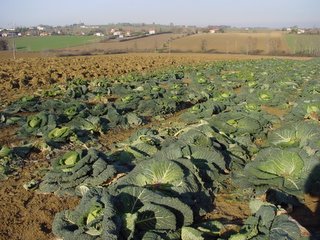 When is a pig not a pig? When it is a green chicken.
When is a pig not a pig? When it is a green chicken.Dog walking days along the driveways of France, those thin white lines on the Michelin map that are township roads, numbered C11, D 2, D296. At Chez Franny in Francescas, Dupont leads us past a field of dew sparkled Savoy cabbages now frost-sweetened in the field. The photograph I took recalled the painting Franny made, which made me think of the very rural regional dishes like a Poule Verte or Green Chicken that Vetou first taught me when I came to this Long Village.
So what does this have to do with the Some Pig Blogging Weekend and my Gascon alphabet? Don’t worry, everything is connected here in the Long Village; rivulets of thoughts lead to streams of consciousness, to raging rivers of words and tidal surges of estuarial action!
This all-important pig... The queen cut of the pig is, of course, the ham—the piece for which we wait the longest: the most expensive, the saltiest, sweetest, most flavorful morsel. Pig butchery time is just around the corner, last year’s pig is mostly gone, and already I am at the ‘J’ word. Jambon. I’ll have to do what we do here in Gascony and make a simple cabbage dish with just the end bits left from last year’s ham or a piece of ventrèche (rolled salted pork belly/bacon). This stuffed ham-scented whole cabbage takes the place of the hen in the traditional poule-au-pot – Good King Henri the 4th’s favorite dish. There are days, even now, when there isn’t a chicken in every pot!
chou by Franny Golden
Vetou Pompèle told me how to make this dish many years ago in front of her French kitchen fireplace. She would assume that you would have all the basic ingredients at hand: a fat Savoy cabbage, some carrots, leeks, courgettes, onions, shallots, and garlic; good farm eggs and sturdy bread, duck fat, milk, and fresh herbs like thyme and parsley, sea salt and lots of freshly ground black pepper and some nutmeg. That’s the basic pantry. Now add a chunk of old ham, (a little rancid ham fat is often used to flavor a soup) or some ventrèche, lardons, or bacon.
Put a big pot of salted water on and when it comes to a boil, blanch the whole cabbage for 5 minutes then drain. While the cabbage is cooking and then cooling, make the stuffing by sautéing until golden a large handful of chopped vegetables like onion, celery and shallots in some duck fat (This IS Southwest France!); tear up enough old bread to make 2-3 cups; moisten this dry bread with some milk, water or wine and squeeze the bread until it is crumbly; add the cooked vegetables, chopped parsley and fresh thyme and roughly chopped up salty pig parts; crack one or two fresh eggs into the mixture, and add salt, nutmeg and pepper- a lot. Now get your hands in and squish the stuffing until it is well mixed. Taste it. Adjust the seasoning. None of this is precise. It’s about making do.
Put another big pot of water on to boil and add the soup vegetables, peeled and cut into big chunks or left whole- carrots, leeks, potatoes, courgettes, some summer-canned tomatoes, etc., add a bouquet garni, salt and a few peppercorns and bring to a simmer.
While the soup starts to simmer, take the cooled cabbage and peel back the leaves gently, until you get to the ‘heart’ – the size of the amount of stuffing you made. Remove this core with a knife or by twisting it out and you will have a hollow whole cabbage. Stuff the hollow with the farce you’ve just made and pull the leaves back over the core, reconstructing the cabbage. Here, I’d use an old gauze ham bag (used to age the ham in the barn) to bundle the cabbage up, but a piece of cheese cloth, an old kitchen towel or even several wraps of kitchen twine will work. Now lower the ‘green chicken’ into the simmering soup and cook until the vegetables are tender and the soup is flavorful. Around 45 minutes. Taste. Often. It’s fun.
When done, serve the soup like a first course with some crusty bread rubbed with garlic floating in the tureen. Then as the main course, serve the stuffed cabbage cut into wedges with the cooked vegetables. I often make a capery-tomato sauce to serve with this though some people just use cornichons, or mustard to offset the sweet vegetables.

There you go, Adam. A very regional winter dish duplicated across France’s most practical agricultural areas using the best of the last bits of that ham that we are about to make all over again…next week. In anticipation and appreciation…‘J’ is for Jambon- le Prince de Janvier!








No comments:
Post a Comment